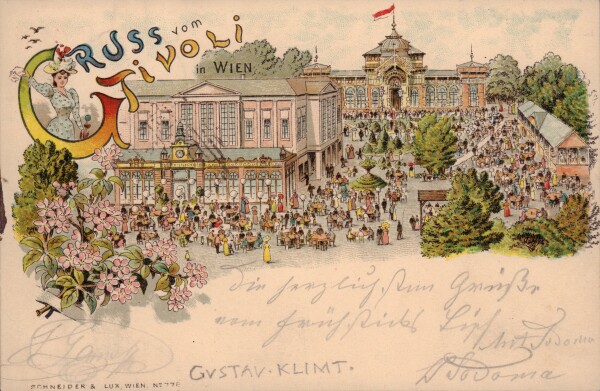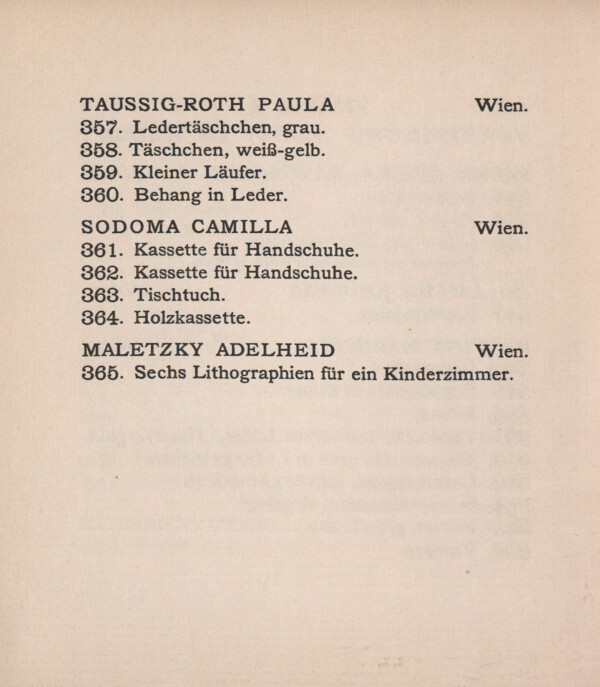The Sodoma Family

Anton Sodoma: Picture Postcard from Anton Sodoma in Vienna to Ferdinand Sodoma in Krieglach, co-signed by Wenzel Sodoma and Gustav Klimt, 08/15/1895, Markus Weissenböck
© Markus Weissenböck, Salzburg

Participation of Camilla Sodoma at the XXVI Secession Exhibition, in: Vereinigung bildender Künstler Österreichs Secession (Hg.): XXVI. Ausstellung der Vereinigung Bildenden Künstler Österreichs Secession, Ausst.-Kat., Secession (Vienna), 00.03.1906–00.05.1906, Vienna 1906.
© Library of the Belvedere, Vienna
Gustav Klimt is known to have been in contact with the drawing teacher Ferdinand Sodoma and his family around the turn of the century. It was especially the two adult daughters, Eugenie (Jenny) and Camilla Sodoma, to whom the artist sent several personal messages.
Ferdinand Sodoma and his wife lived with their two grown-up daughters at Sigmundsgasse 10 in Vienna’s 7th District (Neubau). Ferdinand Sodoma is known to have worked as a drawing professor at a girls’ public school of the Wiener Frauenerwerbsverein, an association promoting the education and employment of women, between 1869 and 1907. Around the turn of the century, his two daughters, Eugenie (Jenny) Sodoma and Camilla Sodoma, worked as elementary school teachers and were active as artists. According to Lehmanns Allgemeiner Wohnungs-Anzeiger, the latter also owned a studio at Zieglergasse 73. Camilla Sodoma presented several decorative art objects at the “XVII. Ausstellung der Vereinigung bildender Künstler Österreichs Secession” [“17th Exhibition of the Association of Austrian Artists Secession”] in 1906 and subsequently repeatedly participated in exhibitions of the Association of Austria Artists.
The exact circumstances of Gustav Klimt’s acquaintance with the Sodoma family remain unknown. Information about their personal relationship – especially between Gustav Klimt and the Sodoma sisters – is mostly provided by a number of surviving letters, all of which are in private hands.
“Camilla’s joy may show in the fan”
Around the turn of the century, Gustav Klimt wrote the Sodoma sisters humorous messages in the form of poems. In one of them he also visually expressed his disappointment about the fact that he had failed to meet the family at home: he combined his text with an illustration of the Sodoma family’s front door at Sigmundsgasse 10, flanking it with flying liquor bottles and hearts.
The surviving correspondence also reveals that Gustav Klimt seems to have decorated a fan for Camilla Sodoma. He repeatedly asked the young woman for patience in several letters because he could not find the time to complete the fan. It was not until the summer of 1899 that Klimt wrote to Camilla Sodoma:
“The fan is ‘finished’ in the full sense of the word. I know you will not be content with me, but I, for my part, feel satisfied that this fan thing has finally been solved before the Dreyfus affair. All the other feelings you will find truthfully inscribed on the fan in golden letters, my dearest mademoiselle.”
Scholars recently assumed that the fan was the one bearing the inscription “Mein Herz, wo ist der Mond?” (“My sweetheart, where is the moon?”), which had previously been associated with Sonja Knips, Alma Mahler-Werfel, and Marie Zimmermann, Klimt’s lover.
Correspondence with Gustav Klimt around 1910
Further messages known to date and written by Gustav Klimt to the family around 1910 certainly suggest a regular contact. They include a picture postcard with which Klimt informed the Sodoma sisters about his departure from the Attersee and a letter of condolence to Luise Sodoma on the occasion of the death of her husband, Ferdinand Sodoma, in May 1910.
Literature and sources
- Sandra Tretter, Peter Weinhäupl (Hg.): Chiffre: Sehnsucht – 25. Gustav Klimts Korrespondenz an Maria Ucicka 1899–1916, Vienna 2014, S. 22.
- Hansjörg Krug: Gustav Klimt selbstredend, in: Tobias G. Natter (Hg.): Gustav Klimt. Sämtliche Gemälde, Vienna 2012, S. 461-504.
- Agnes Husslein-Arco, Alfred Weidinger (Hg.): Gustav Klimt 150 Jahre, Ausst.-Kat., Upper Belvedere (Vienna), 13.07.2012–27.01.2013, Vienna 2012, S. 287.
- Alfred Weidinger (Hg.): Gustav Klimt, Munich - Berlin - London - New York 2007, S. 212-213.
- Neuigkeits-Welt-Blatt, 27.11.1891, S. 11.
- Vereinigung bildender Künstler Österreichs Secession (Hg.): XXVI. Ausstellung der Vereinigung Bildenden Künstler Österreichs Secession, Ausst.-Kat., Secession (Vienna), 00.03.1906–00.05.1906, Vienna 1906, S. 46.
- N. N.: Wiener Frauenerwerbverein, in: Neue Freie Presse, 27.06.1907, S. 10.

